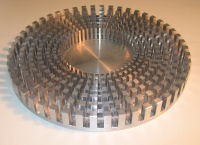Oct 2 2008
Scientists at the University of Liverpool have tested an 'invisibility cloak' that could reduce the risk of large water waves overtopping coastal defences.
 The 'invisibility cloak' consists of pillars that guide water along corridors to its centre.
The 'invisibility cloak' consists of pillars that guide water along corridors to its centre.
Mathematicians at Liverpool, working with physicists at the Centre National de la Recherche Scientifique (CNRS) and Aix-Marseille Universite have found that coastal defences could be made ‘invisible' when water is guided through a special structure called metamaterial.
Metamaterial was first invented by Sir John Pendry at Imperial College London where scientists discovered that this unique structure could bend electromagnetic radiation – such as visible light, radar or microwaves – around a spherical space, making an object within this region appear invisible.
The new structure is cylindrical and consists of rigid pillars that help guide water along concentric corridors. The pillars interact with the water, guiding it in different directions along the corridors and increasing its speed as it nears the centre of the structure - similar to a whirlpool. The water waves, however, are never broken-up and exit the structure as though they had never been disturbed.
Dr Sebastien Guenneau, from the University’s Department of Mathematical Science, explains: “Defending land against flooding and tidal waves is a big issue for scientists and engineers all over the world. Coastal defences have to withstand great forces and there is always a risk of water overtopping or penetrating these structures. Water crashes against these defences, breaking the wave and causing a lot of damage to roads and property hidden behind them.
“What is unique about this new structure is that it interacts with the water, guiding it to a particular destination rather than breaking it up and sending it everywhere. It is as though the defences are invisible to the wave and as such it does not recognise the structure as an obstacle. This makes it easier to manipulate water waves.
“We now need to investigate how to replicate this effect in a ‘real’ life situation to protect land from natural disasters such as tsunamis, and defend other structures such as oil rigs in the ocean.”
The research is published in Physical Review Letters.